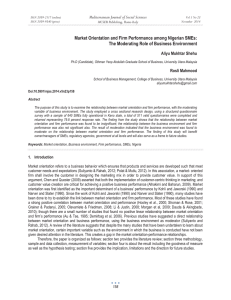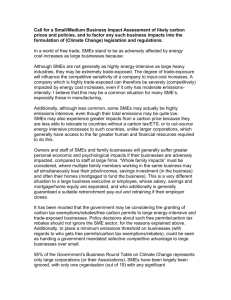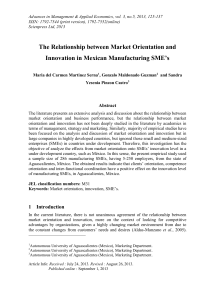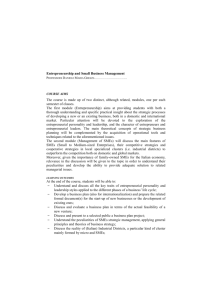Market Orientation & Planning Flexibility in SMEs Abstract
advertisement
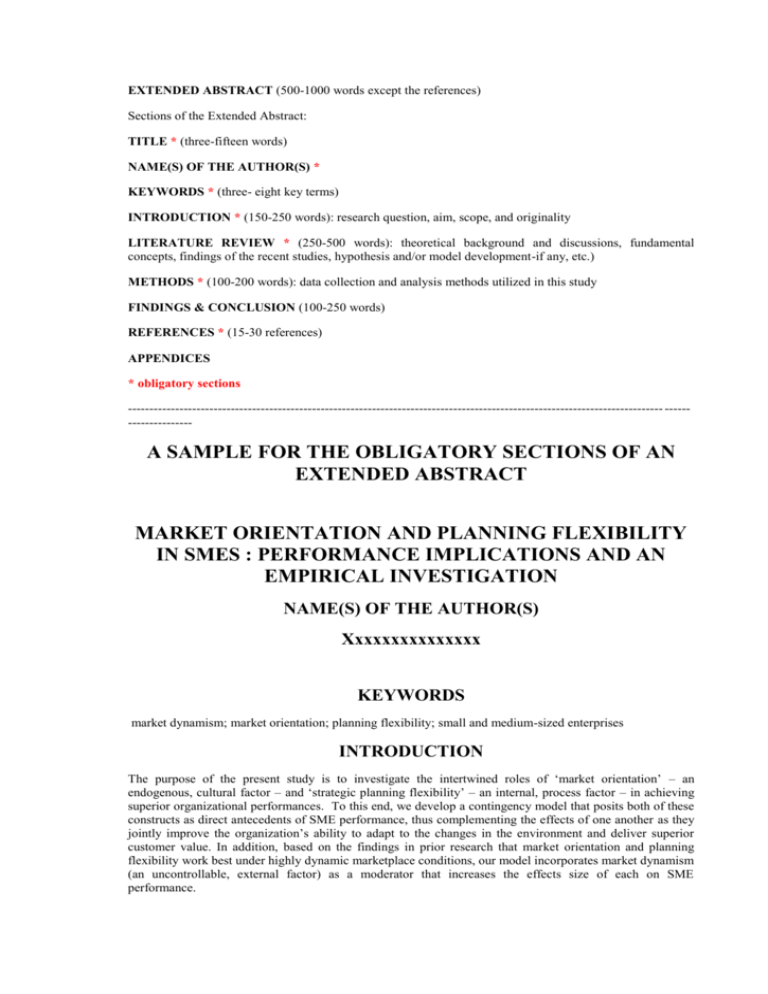
EXTENDED ABSTRACT (500-1000 words except the references) Sections of the Extended Abstract: TITLE * (three-fifteen words) NAME(S) OF THE AUTHOR(S) * KEYWORDS * (three- eight key terms) INTRODUCTION * (150-250 words): research question, aim, scope, and originality LITERATURE REVIEW * (250-500 words): theoretical background and discussions, fundamental concepts, findings of the recent studies, hypothesis and/or model development-if any, etc.) METHODS * (100-200 words): data collection and analysis methods utilized in this study FINDINGS & CONCLUSION (100-250 words) REFERENCES * (15-30 references) APPENDICES * obligatory sections ----------------------------------------------------------------------------------------------------------------------------- -------------------- A SAMPLE FOR THE OBLIGATORY SECTIONS OF AN EXTENDED ABSTRACT MARKET ORIENTATION AND PLANNING FLEXIBILITY IN SMES : PERFORMANCE IMPLICATIONS AND AN EMPIRICAL INVESTIGATION NAME(S) OF THE AUTHOR(S) Xxxxxxxxxxxxxxx KEYWORDS market dynamism; market orientation; planning flexibility; small and medium-sized enterprises INTRODUCTION The purpose of the present study is to investigate the intertwined roles of ‘market orientation’ – an endogenous, cultural factor – and ‘strategic planning flexibility’ – an internal, process factor – in achieving superior organizational performances. To this end, we develop a contingency model that posits both of these constructs as direct antecedents of SME performance, thus complementing the effects of one another as they jointly improve the organization’s ability to adapt to the changes in the environment and deliver superior customer value. In addition, based on the findings in prior research that market orientation and planning flexibility work best under highly dynamic marketplace conditions, our model incorporates market dynamism (an uncontrollable, external factor) as a moderator that increases the effects size of each on SME performance. The article proceeds in the following manner. First, we briefly review the literature regarding market orientation and planning flexibility. We develop hypotheses concerning the effects of market orientation and planning flexibility on SME performance. Second, we incorporate market dynamism into our theoretical analyses and discuss its moderating role in the performance impacts of market orientation and planning flexibility. Next, we test our hypotheses using data from 312 manufacturing SMEs in Turkey. We explain in detail the data collection method and analytical procedures. Finally, we provide the research findings and discuss their managerial and theoretical implications. LITERATURE REVIEW Factors contributing to the competitive performance of small and-medium-sized firms (hereafter SMEs) have long been attracting the attention of researchers and business owners/managers. Research in the strategic management literature provides a long list of strategic, structural, managerial, cultural and procedural aspects as antecedents of high performance in SMEs (e.g. Churchill and Lewis, 1983; Covin and Covin, 1990; Deshpande and Parasuvaran, 1986; Shuman et al, 1985). The main postulate of this research stream is that superior performance in the competitive arena requires an effective combination of all relevant internal organizational elements, i.e. strategy, culture, climate, processes and procedures enabling greater adaptability to the rapidly changing customer preferences and dynamic marketplace factors (Baker et al., 1999; Naman and Slevin, 1993). Accordingly, a market-oriented organizational culture and flexible strategic planning approach have been suggested as key performance leverages for business firms (e.g. Barringer and Bluedorn, 1999; Slater and Narver, 1998). Market orientation is a specific form of organizational culture that focuses on ‘delivering products and services valued by customers, usually accomplished through ongoing monitoring of market conditions, and adaptation of organizational responses’ (Grewal and Tansuhaj, 2001: 67). Pelham and Wilson (1996) assert that a market oriented culture is the main source of competitive advantage for today’s business firms, facilitating customer-driven value creation. A market oriented organizational culture may work as a critical driver of various aspects of superior performance including product quality, new product success, and profitability not only for large-scale firms (e.g. Deshpande et al., 1993; Hult and Ketchen, 2001; Jaworski and Kohli, 1993; Kohli and Jaworski, 1990; Morgan and Strong, 1998; Narver and Slater, 1990; Noble et al., 2002; Slater and Narver, 1994) but also for SMEs (e.g. Appiah-Adu and Singh, 1998; Pelham, 1999, 2000; Pelham and Wilson, 1996). H1: The level of market orientation in SMEs will be positively related to their overall performance. Organizational strategy needs to be aligned with organizational culture and environmental challenges. Therefore, planning provides a detailed flow of activities that help in shaping the minds of organizational members and organizing the procedures employed by the various departments. However, any lack of flexibility potentially limits firms’ capabilities to respond to radical change (e.g. Richbell et al., 2006; Spicer and Sadler-Smith, 2006). Therefore, if not accompanied with an organizational ability to better anticipate and react to the changing environmental conditions (Risseuw and Masurel, 1994), a rigid commitment of the firm’s resources to a specific strategic direction (i.e. a rigid plan) may limit the capability of generating contingent repositionings (Slotegraff and Dickson, 2004). H2: The level of planning flexibility in SMEs will be positively related to their overall performance. METHODS Data were collected through face-to-face interviews with top executives of the SMEs in the Turkish manufacturing industry. The sampling frame consists of randomly selected 1000 manufacturing SMEs employing less than 250 employees. As a result, the effective sample size of the study is 312. The constructs in our study are developed by using measurement scales adopted from prior studies. All constructs are measured using seven-point Likert scales with anchors strongly disagree (= 1) and strongly agree (= 7). Items for measuring Market Orientation are adopted from Narver and Slater (1990). This scale consists of items measuring the Customer Orientation (6 items), Competitor(s) Orientation (4 items), and Interfunctional Coordination (5 items) components of market orientation. The Planning Flexibility scale (9 items) is adopted from Barringer and Bluedorn (1999). Similarly, selected items from Appiah-Adu and Singh (1998) and Pelham and Wilson (1996) are used for measuring Market Dynamism (6 items). Items in this scale assess the rate of change in customer needs, competitors’ strategies, products, and technology. Finally, seven items are adopted from Homburg et al. (1999) to measure different aspects of SME Performance, such as profitability, market share, customer satisfaction, and adaptability. REFERENCES 1. Appiah-Adu, K. and Singh, S. (1998) ‘Customer Orientation and Performance: A Study of SMEs’, Management Decision 36(6): 386–7. 2. Baker, T., Hunt, T. and Hawes, J. (1999) ‘Marketing Strategy and Organizational Culture’, Journal of Marketing Management 9(2): 32–46. 3. Barringer, B. R. and Bluedorn, A. C. (1999) ‘The Relationship between Corporate Entrepreneurship and Strategic Management’, Strategic Management Journal 20(5): 421–44. 4. Churchill, N. and Lewis, V. L. (1983) ‘The Five Stages of Small Business Growth’, Harvard Business Review 61(3): 30–50. 5. Covin, J. G. and Covin, T. J. (1990) ‘Competitive Aggressiveness, Environmental Context, and Small Firm Performance’, Entrepreneurship: Theory & Practice 14(4): 35–51. 6. Deshpande, R. and Parasuvaran,A. (1986) ‘Linking Corporate Culture to Strategic Planning’, 7. Business Horizons 29(3): 28–37. 8. Deshpande, R., Farley, J. U. and Webster, F. (1993) ‘Corporate Culture, Customer Orientation, and Innovativeness in Japanese Firms: A Quadrad Analysis’, Journal of Marketing 57(1): 23–7. 9. Grewal, G. and Tansuhaj, P. (2001) ‘Building Organizational Capabilities for Managing 10. Economic Crisis: The Role of Market Orientation and Strategic Flexibility’, Journal of Marketing 65(2): 67–80. 11. Homburg, C., Krohmer, H. and Workman, J. P. (1999) ‘Strategic Consensus and Performance: The Role of Strategy Type and Market-Related Dynamism’, Strategic Management Journal 20(4): 356– 7. 12. Hult, G. T. M. and Ketchen, D. J., Jr (2001) ‘Does Market Orientation Matter?: A Test of the Relationship Between Positional Advantage and Performance’, Strategic Management Journal 22(9): 899–906. 13. Jaworski, B. and Kohli, A. (1993) ‘Market Orientation: Antecedents and Consequences’, Journal of Marketing 57(3): 53–70. 14. Kohli, A. and Jaworski, B. (1990) ‘Market Orientation: The Construct, Propositions and Managerial Implications’, Journal of Marketing 54(2): 1–18. 15. Morgan, R. E. and Strong, C. A. (1998) ‘Market Orientation and Dimensions of Strategic Orientation’, European Journal of Marketing 32(11–12): 1051–73. 16. Naman, J. and Slevin, D. (1993) ‘Entrepreneurship and the Concept of Fit’, Strategic Management Journal 14(2): 137–53. 17. Narver, J. and Slater, S. (1990) ‘The Effect of a Market Orientation on Business Profitability’, Journal of Marketing 54(4): 20–35. 18. Noble, C. H. Sinha, R. K. and Kumar, A. (2002) ‘Market Orientation and Alternative Strategic Orientations: A Longitudinal Assesment of Performance Implications’, Journal of Marketing 66(4): 25–39. 19. Pelham, A. M. and Wilson, D. T. (1996) ‘A Longitudinal Study of the Impact of Market Structure, Firm Structure, Strategy, and Market Orientation, Culture on Dimension of Small Firm Performance’, Journal of The Academy of Marketing Science 24(1): 27–43. 20. Pelham, A. M. (1999) ‘Influence of Environment, Strategy, and Market Orientation on Performance in Small Manufacturing Firms’, Journal of Business Research 45(1): 33–46. 21. Pelham,A. M. (2000) ‘Market Orientation and Other Potential Influences on Performance in Small and Medium-Sized Manufacturing Firms’, Journal of Small Business Management 22. Richbell, S., Watts, D. and Wardle, P. (2006) ‘Owner-managers and Business planning in the Small Firm’, International Small Business Journal 24(5): 496–514. 23. Risseuw P. and Masurel, E. (1994) ‘The Role of Planning in Small Firms: Empirical Evidence from a Service Industry’, Small Business Economics 6(4): 313–22. 24. Shuman, J. C., Shaw, J. J. and Susmann, G. (1985) ‘Strategic Planning in Smaller Rapid Growth Companies’, Long Range Planning 18(6): 48–55. 25. Slater, S. F. and Narver, J. C. (1994) ‘Does Competitive Environment Moderate the Market Orientation-Performance Relationship?’, Journal of Marketing 58(1): 46–55. 26. Slater, S. F. and Narver, J. C. (1998) ‘Customer-led and Market-oriented: Let’s not Confuse the Two’, Strategic Management Journal 19: 1001–6. 27. Slotegraff, R. and Dickson, P. (2004) ‘The Paradox of a Marketing Planning Capability’, Journal of the Academy of Marketing Science 32(4): 371–85.Spicer and Sadler-Smith, 2006


